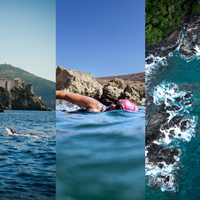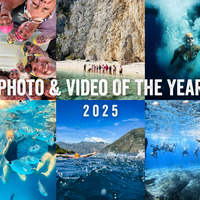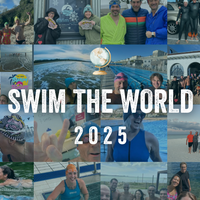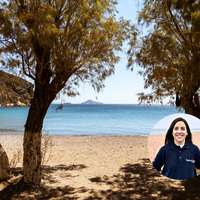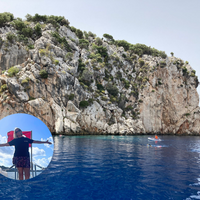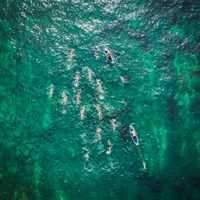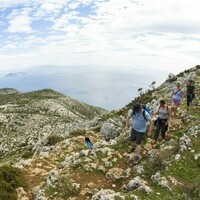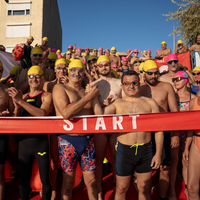Paul Newsome is a veritable swim-Yoda with many years' experience in video analysis and stroke correction. In fact, very few coaches have a more impressive record of breaking bad aquatic habits to improve swimmer's speed and efficiency. An international marathon swimmer himself, Paul founded the company Swim Smooth back in 2004. Since 2010, Paul has been providing his unique coaching methodology to many of the world’s most prolific governing bodies like British Triathlon and the International Triathlon Union.
Paul swam the English Channel in 2011. Then, in 2013, he finished first in the 48-km invitational Manhattan Island Marathon Swim. He also co-authored a popular book, titled 'Swim Smooth', which delves deep into technique and training methods and serves as a handbook for swimmers of all abilities.

We're delighted to say that Paul will be joining us to lead our Introduction To Open Water trip in Bali this year. He will bring all his expertise, charisma and swim analysis resources to the coastal waters of Indonesia and our sunlit pool at the stunning Blue Earth Village. SwimTrekkers - get ready to train smarter and learn from the best!
In this interview, we reached out to Paul at his Perth home in Western Australia. We did our best to swerve any sharky subjects and opted instead to talk about 'sinky legs', deep water fear and the most common bad habits picked up by swimmers in pools and open water...

So Paul, let’s start with this… what are the most common bad habits you spot when analysing a swimmer’s technique?
"One of the most common things afflicting many swimmers that I take for video analysis sessions are low 'sinky legs' in the water, especially male swimmers. Some of that gets masked a little bit when you're on a SwimTrek in the Mediterranean, or some other beautiful part of the world where you stay buoyant in the sea. One of the benefits of doing the video analysis in Bali is that we're going to be able to spot body position issues immediately in the resort’s pool. 'Sinky legs' are a very common affliction and can be typically caused by about five different factors:"
Breathing: "Many people skip over the fact that breathing is one of the most commonly overlooked aspects of the freestyle stroke. Many people actually hold onto their breath underneath the water. What they want to be doing is actually exhaling to reduce buoyancy in the chest cavity, which helps to lift the legs a little higher. It also makes you feel a lot more comfortable and relaxed in the water. If you're fairly new to swimming chances are you’ll be finding that breathing is a big limiting factor and this can really impact your body position and how hard swimming ultimately feels."
''Sinky legs' are a very common affliction. It can be caused by a number of things - about five different things...'
Sighting: "A lot of swimmers look too far forwards in the water. Some swimmers need to do that if they've got good body position, or if they're sighting in the open water. But for some, if the head position is a little too far forwards that can also cause the legs to sink. I've worked with one such swimmer, who made this adjustment to his head position - this is going to sound unbelievable - but it made a 9-minute improvement over 1500 metres. There were a number of other factors that worked on besides just his head position, but his perception was that the head position seemed to make all the difference for him. Getting the head position sorted for someone with low 'sinky legs' is really important."
Hand Position (Crossing Over): "We see this a lot in the open water if someone is crossing over in front of their head. Usually that crossover nudges their legs apart, which again creates drag and pulls the legs down."
Arm Position: "A lot of swimmers tend to pull through with a very straight arm and end up pulling too deep underneath the water. That gives them lift at the front, but again sinks the legs down at the back."
Flexibility: "Final thing, this is simply flexibility. We all spend a lot of time stooped over our computers and spend a lot of time sat down. If your hip flexors become really tight – the muscles at the front of the hips – this will also negatively affect the body position in the water as shortened hip flexor muscles tend to drop the legs further. So simple stretches to improve flexibility in the hips and the upper back, and even the ankles as well, will hugely improve someone's body position. It's probably the biggest aspect that we see especially with somebody who is swimming 1:45 to 2:30 per 100 range. Chances are if this is you body position and drag is going to be a big factor on your swimming."

Okay, so what's the ideal head position - is it directly down?
"Good question - there is no ideal head position. For as many swimmers as I tell to look down, I'll be telling just as many to look forwards in the water. You almost want to think of the head position as being like a tuning fork. Some people should look down. Others should look further forward. It's about working with the individual athlete on a one-to-one basis."
What are the key things you're looking for when it comes to improving stroke efficiency and speed?
"First and foremost I'll be working out what is the key aspect that's actually holding the swimmer back. So I work on the principle of cause and effect. When you're doing video analysis it's really easy to pick up 10 to 15 faults in somebody's stroke. Anybody who's watched any YouTube videos will immediately become self-critical when watching themselves on video and they'll typically start to identify all of their faults as well. They'll start to beat themselves up about it which can have a very demotivating effect. If you use the principle of cause and effect and basically try and identify what is causing what within the stroke - you can simplify the process. For example, I mentioned about crossing over in front of the head, when you look at someone's stroke you can really see that cross over when viewed from a bird’s eye view looking down. You see the scissoring of the legs much more profoundly. You can easily think there's two problems there. Crossing over and scissoring. Rather than working out it's actually the scissoring being caused by the cross over, which causes the legs to sink and creates drag, making them slower."
"Simplifying in this way is the process I tend to go through. It's probably the most important thing when working on someone's efficiency by ensuring you don’t overwhelm them. It's important to always bring them back to the idea that: 'this is being caused by this, which causes that, which causes this... so, let's focus on that one area we need to work on'."
'I basically have a GoPro on my chest and I film the swimmer making the progress and they can hear my coaching points over the top of it. Most importantly they can see themselves improving...'
"At the end I'll kind of summarise by asking: 'what did you get from this session?' I want to hear about the one thing that made the big difference. I'll actually get them to talk to me like they were telling a friend over a cup of coffee. If their friend doesn't know about swimming (and possibly isn't even that interested hearing about it!), what would they tell them in a nutshell that they learned in this one-to-one which made the biggest difference? It helps to simplify in the swimmer's mind exactly what they need to focus on."
"When I'm in Bali and working with the swimmers there doing video analysis the process will involve filming the swimmer, sitting down with the swimmer and going through the analysis and actually recording that analysis. Sometimes you can start to see swimmers concentration waning a little, so I'll say "don't panic, this is all being recorded" and when they get home they can watch it back through. One of the cool things I've been doing over the last 12 months - I'm really excited to do this with the swimmers in Bali - is film the stroke correction process from a coach's eye view. I basically have a GoPro on my chest and I film the swimmer making the progress and they can hear my coaching points over the top of it. Most importantly they can see themselves improving too later which when coupled with how they felt with the improvements can be a really powerful thing."

What are the most important safety measures open water swimmers should keep in mind after making that transition from the pool?
"The first thing that springs to my mind is the temperature of the water. Swimmers need to be aware of what it means to get into, for example, 15C versus 25C. Whether or not they should be in a wetsuit or not. Having the wetsuit on also provides a really good buoyancy measure as well. So, newer swimmers, especially in colder waters, are always well-advised to use a wetsuit. Just because it helps with thermo-regulation and also their buoyancy profile as well."
"A couple of other factors as well - just knowing the waters and currents and rips is vital. Where we swim over here in Western Australia we've got some pretty big ocean swells and rip currents. Knowing those conditions is really important. The best way to find out about that is just to ask somebody local, specifically a local lifeguard on the beach. Ask them where the currents are before you get in. I'd always encourage anyone open water swimming to swim with a buddy of similar speed. That way you can actually just check on each other. While they're not very popular over here in Australia - in fact, I don't know anybody who uses one - tow floats are very popular in Europe and the UK and they're fantastic. They just give a little more visibility to the swimmer out in the ocean. So it helps boats to keep an eye on swimmers as well."
"I guess the final factor would be to just let somebody know where you're going to swim. Typically I'll say to my wife I'm going to go for a swim at 'such-and-such' a beach and I get down and it's actually not very nice - I'll go somewhere else. It's obviously important to let them know that you've changed location and moved on!"
"I'll always swim with a partner and we've usually sussed-out the depth of the area and we know if there are any... 'marine hazards', let's call it. Sharks are a very real and present danger for us over here. Obviously one of the nice things about coming over to Europe, or Indonesia, is the risk is much, much lower than what it is down here."

Do you ever speak to any swimmers who are about to make that transition, but have a fear of open water? Or, have tried it and felt that deep water fear? If so, what kind of advice do you offer to overcome that particular fear?
"One of the most important things is empathy. Believe it or not, I've been swimming competitively since I was 7 and didn't try open water swimming until I was 16. While that still sounds quite young the primary reason I didn't get into it earlier was because I was really fearful of deep open water. For me, I actually went and did a PADI diving course in Thailand when I was 23, which helped me get over that fear. Everyone has a different trigger. For me, it's deep water when it's crystal clear and you can see all the way down to the bottom. So, it's a little like a vertigo thing. If it's really murky I don't mind that at all. If it's clear my imagination runs wild, basically. It's working out what those triggers are."
"When you're swimming in the UK lakes and river, things like weeds touching your feet can really put people off. The biggest thing people tend to do when anxious is hold onto their breath. That exacerbates that feeling of anxiety further. It almost goes back to what I said about exhalation in the water. If you can get someone to exhale and focus on the bubbles in the water it's a really good way to distract them from the fear and anxiety. Bring them back to a nice centred place. Breathe-bubble-bubble-breathe is the mantra!"
'Everyone has a different trigger. For me, it's deep water when it's crystal clear and you can see all the way down to the bottom. So, it's a little like a vertigo thing...'
It doesn't really have anything to do with ability. I was speaking to a Masters swimmer who was just starting to swim in open water. She'd done the Alcatraz swim, but she said she did most of it backstroke for fear of looking down – thinking of sea lions and sharks...
"Yeah - as a prime example of that, I've done some filming with Rebecca Adlington, Olympic gold medallist and former world record holder in the 800-metre freestyle. We discussed this about open water swimming and she said she's the most fearful person of anybody she knows! Here's arguably one of the most competent athletic swimmers ever and she's fearful of swimming in the open water – just like I was before I got hooked on it and addressed my anxiety triggers. It can happen to anyone. So, ability level is not really a factor. I see just as many very good swimmers who really struggle with it and won't venture out into open water. It's a real shame because as we know it's a great place to be when it's safe and you're well catered for."

Last one's more light-hearted - just of all the places you've swum in the world, what's your favourite swim spot?
"Oh, God - it's a hard one because I've swum in so many different places. A real highlight for me, because I go back there every year, is actually Mallorca. I love swimming in the Mediterranean around there. It's just crystal clear and for me it's makes me feel quite relaxed since I'm not in Western Australia where there might be some sharks. I think a lot of my best swim spots involve being in places where there aren't any sharks (laughs). I know it sounds funny, but it's dead true. That being said I have swum at Alcatraz as well. Just a really memorable swim. I'd just won the Manhattan Island swim in 2013 and we did a road trip across America from New York to San Francisco. It was 14-15C in the water. We got out and at the South End Rowing Club they have this amazing sauna with a strip window that looks out at the Golden Gate Bridge. I'll never, ever forget that swim."
"That was a real pinch-me moment."
'We got out and at the South End Rowing Club they have this amazing sauna with a strip window that looks out at the Golden Gate Bridge. I'll never, ever forget that swim.'
For anyone keen to swim under Paul's world-class tutorage, you can still book spaces to join us for our upcoming Introduction To Open Water - Bali trips this year...


